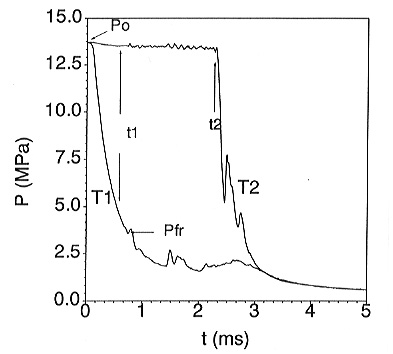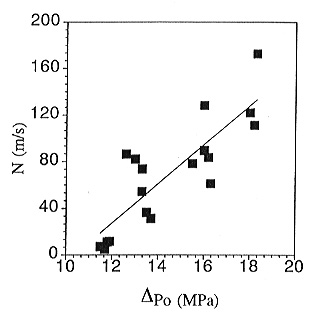

During rapid decompression of lava domes and cryptodomes caused by collapse
events, fragmentation of highly viscous magma can occur. To study this
phenomena experiments were recently performed on fragmentation of gray
dacite of the May 18, 1980 Mount St. Helens eruption, at temperatures up
to 915°C and a pressure differential of  12 MPa using a recently developed high-temperature shock-tube type apparatus.
Brittle disruption of the dacite was observed over the entire experimental
temperature range (15 � 915°C) implying that during rapid decompression,
the behaviour of highly viscous vesicular dacite is similar to the behaviour
of solid vesicular dacite. Experiments on dacite fragmentation at moderate
temperatures offer the obvious advantage of direct measurements and observations
during fragmentation, which are very difficult to conduct at high temperature.
To understand the mechanism of highly viscous vesicular magma fragmentation
by rapid decompression at high temperature conditions it is important to
know the mechanism of fragmentation of such vesicular rocks under room
temperature conditions.
12 MPa using a recently developed high-temperature shock-tube type apparatus.
Brittle disruption of the dacite was observed over the entire experimental
temperature range (15 � 915°C) implying that during rapid decompression,
the behaviour of highly viscous vesicular dacite is similar to the behaviour
of solid vesicular dacite. Experiments on dacite fragmentation at moderate
temperatures offer the obvious advantage of direct measurements and observations
during fragmentation, which are very difficult to conduct at high temperature.
To understand the mechanism of highly viscous vesicular magma fragmentation
by rapid decompression at high temperature conditions it is important to
know the mechanism of fragmentation of such vesicular rocks under room
temperature conditions.
The main objectives of the present experiments on dacite fragmentation at room temperature were therefore: (1) to determine the value of the pressure drop and the moment of the onset of fragmentation, (2) to measure the duration of the fragmentation event and the fragmentation velocity, (3) to constrain further a mechanistic model for fragmentation.
The fragmentation dynamics of vesicular gray dacite have been studied at room temperature. The experimental apparatus consists of a high pressure section and a low pressure section vented into a large tank (Annual Report 1995). Cylindrical dacite samples (diameter = 17 mm, length = 50 mm) are placed in the high pressure section of the apparatus, saturated by argon gas and rapidly depressurized from initial pressures of 1.0 - 18.5 MPa down to 0.1 MPa via the disruption of a diaphragm located between the high and low pressure sections. Samples of the 1980 Mt. St. Helens cryptodome dacite, whose physical properties of have been well documented (Annual Report 96) were used in the experiments. The high-pressure section was equipped with two piezoelectric pressure transducers installed near the free surface of the sample and beneath the sample, respectively. These transducers provide a record of the pressure history during fragmentation.
The main results may be summarized as follows: (1) Fragmentation occurs
when the value of the pressure drop on the sample surface  P exceeds the critical fragmentation pressure
P exceeds the critical fragmentation pressure  Pfr
Pfr  8.5 - 12.0 MPa (Fig.
3.7-2). The value of
8.5 - 12.0 MPa (Fig.
3.7-2). The value of  Pfr increases
with an increase in the initial pressure differential between the high
and low pressure sections
Pfr increases
with an increase in the initial pressure differential between the high
and low pressure sections  P0; (2)
The time interval between the beginning of sample decompression and the
beginning of fragmentation, t1
P0; (2)
The time interval between the beginning of sample decompression and the
beginning of fragmentation, t1  0.5 - 2.0 ms, decreases with increasing
0.5 - 2.0 ms, decreases with increasing  P0. The time interval between the beginning of sample decompression
and the end of sample fragmentation t2
P0. The time interval between the beginning of sample decompression
and the end of sample fragmentation t2  0.8 - 11.4 ms also decreases with increasing
0.8 - 11.4 ms also decreases with increasing  P0. The effective decompression rate corresponding the fragmentation
onset | dP/dt |fr
P0. The effective decompression rate corresponding the fragmentation
onset | dP/dt |fr  5.0 - 23.0 MPa/ms increases
with the increase of
5.0 - 23.0 MPa/ms increases
with the increase of  P0; (3) The
fragmentation velocity, N, is in the range of ~5 - 170 m/s and increases with an increase in
P0; (3) The
fragmentation velocity, N, is in the range of ~5 - 170 m/s and increases with an increase in  P0 (Fig. 3.7-3); (4) Dacite fracturing is accomplished by the
propagation of a fragmentation wave front that generates a layer-by-layer
P0 (Fig. 3.7-3); (4) Dacite fracturing is accomplished by the
propagation of a fragmentation wave front that generates a layer-by-layer
 |
 P0=13.7 MPa. General
view, showing the time of fragmentation onset (t1) and the time of fragmentation
cessation (t2), and peak on the pressure curve (Pfr) recorded by transducer
T1, corresponding to the fragmentation onset. P0=13.7 MPa. General
view, showing the time of fragmentation onset (t1) and the time of fragmentation
cessation (t2), and peak on the pressure curve (Pfr) recorded by transducer
T1, corresponding to the fragmentation onset. |
 |
 P0). P0). |
fracturing of dacite and ejection of fragmentation products by a high
pressure gas expanding towards the low pressure zone. At  P0 only slightly exceeding the threshold for fragmentation the
process can exhibit a multiple or sequential character and is characterized
by very low effective fragmentation velocities ( ~5 m/s).
P0 only slightly exceeding the threshold for fragmentation the
process can exhibit a multiple or sequential character and is characterized
by very low effective fragmentation velocities ( ~5 m/s).

Tel: +49-(0) 921 55 3700 / 3766, Fax: +49-(0) 921 55 3769, E-mail: bayerisches.geoinstitut(at)uni-bayreuth.de
 Previous page
Previous page